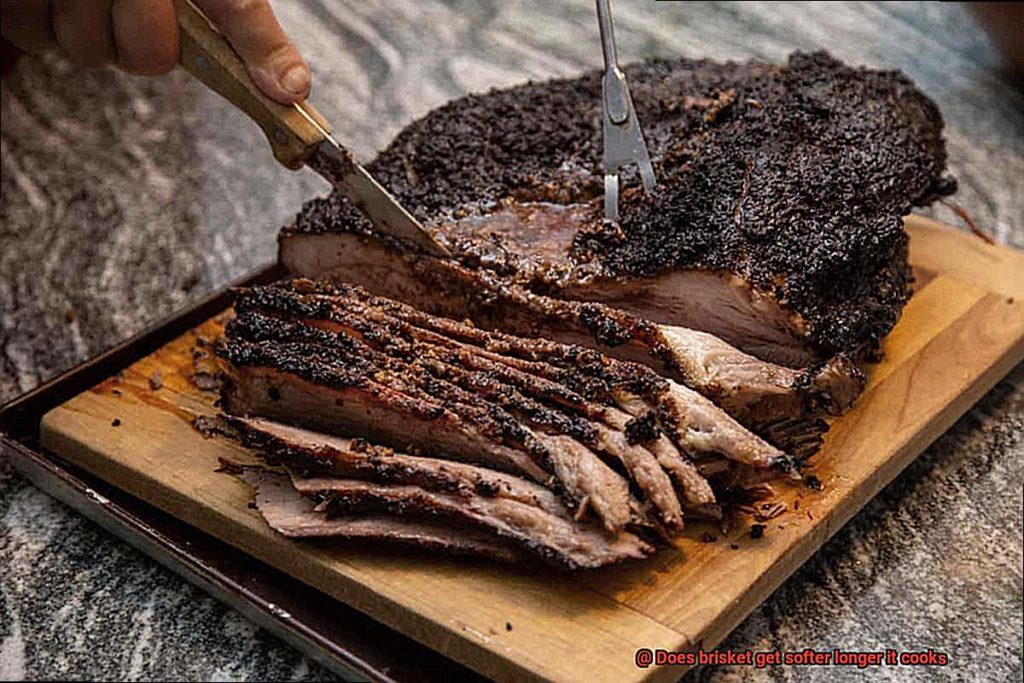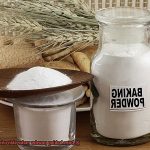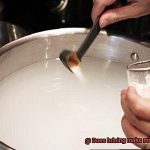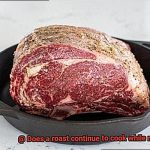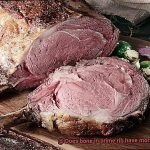Are you a BBQ enthusiast who can’t resist the mouth-watering temptation of brisket? Then you know it’s notoriously tricky to get right. Cooking brisket requires expertise, patience, and precision to achieve the perfect balance of tenderness and flavor. But does it get softer the longer it cooks? The answer is a resounding yes, but there’s much more to this Southern staple than meets the eye.
Cooking brisket is an art form that demands attention to detail. The quality of meat you use makes a significant difference in how tender your brisket becomes. Even if you cook a tough cut for hours on end, it will never be as tender as a high-quality one. Additionally, different cooking methods produce different results, meaning that smoking, braising or roasting will require varying lengths of time.
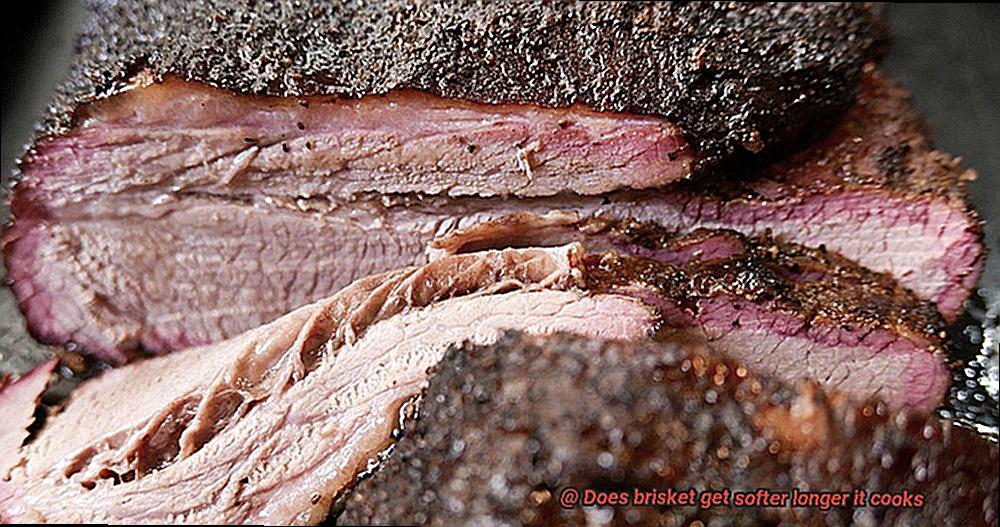
In this post, we’ll dive deep into the science behind why brisket gets softer as it cooks. We’ll also explore all the factors that influence cooking time for this delicious cut of meat. So sit back with a cold drink and roll up your sleeves because we’re about to uncover all the secrets behind making the perfect brisket.
Contents
What is Brisket?
Brisket is an intriguing cut of meat that comes from the breast or lower chest of a cow. It possesses a rich, beefy flavor that can be enjoyed through various cooking methods such as smoking, grilling, and barbecuing. However, its toughness can pose a challenge to even the most seasoned chefs.
It is important to note that brisket is composed of two muscles: the flat and the point. The flat muscle is lean and flat, while the point muscle is fattier and more marbled. Each muscle requires different cooking times and techniques to achieve optimal tenderness.
While it’s true that cooking brisket for a long time can help break down its tough fibers and make it tender, there is a fine line between tender and dry. The key to achieving tender brisket is finding the right balance between cooking time and temperature. Cooking at low temperatures for a long time, known as “low and slow,” gradually breaks down connective tissues while maintaining moisture.
Quality of meat also plays a role in the texture of your brisket. Brisket from older or stressed animals may be tougher and require longer cooking times to achieve tenderness. On the other hand, high-quality brisket from younger animals may become tender more quickly.
To check for doneness, use a meat thermometer to measure the internal temperature of the meat. When it reaches around 195-205°F, it should be tender and juicy.
Does Brisket Get Softer the Longer it Cooks?
Brisket – the ultimate challenge for any pitmaster or home cook seeking meaty perfection. While this cut of beef can be incredibly delicious, it’s also notoriously tough and requires a lot of patience and skill to prepare correctly. So, does brisket get softer the longer it cooks? The answer is yes, but there are some important nuances to consider.
At the heart of the matter lies collagen breakdown, a key process that determines the texture of meat. Collagen is a protein found in connective tissue that gives strength and structure to muscles. When heated, collagen transforms into gelatin which provides a softer texture and makes meat more tender. This transformation takes time and occurs at low temperatures, which is why slow-cooking methods like smoking or braising are recommended for brisket.
However, there’s a fine line between perfectly cooked brisket and an overcooked disaster. The longer you cook brisket, the more moisture and fat will be lost, resulting in dry and tough meat. To avoid this, it’s essential to monitor the internal temperature of the meat and remove it from heat at the right time. The ideal temperature range for brisket is between 195°F and 205°F, at which point the meat should be tender and juicy.
But how long will it take to reach this sweet spot? That depends on several factors such as the size of the brisket, the cooking method used, and the desired level of doneness. Generally speaking, you should plan on cooking brisket for at least 1 hour per pound at low heat (225°F-250°F), but it may take longer depending on your particular circumstances.
To summarize: yes, brisket does get softer as it cooks thanks to collagen breakdown into gelatin. However, cooking time and temperature must be carefully controlled to prevent overcooking and ensure optimal tenderness and juiciness. Keep an eye on the internal temperature of the meat and remove it from heat when it reaches 195°F-205°F for best results.
Factors That Affect How Long to Cook Brisket
Brisket can be a daunting task, especially for beginners. But don’t worry, we’ve got you covered with the factors that affect how long to cook brisket.
First off, let’s talk about size. The size of the brisket is the most crucial factor in determining cooking time. The larger the brisket, the longer it will take to cook thoroughly. So if you’re dealing with a 12-14 pounder, prepare for it to take around 10-12 hours at 225-250°F. Trust us; the wait will be worth it.
Now, let’s dive into cooking methods. Whether you choose to smoke, roast or slow-cook your brisket, each method requires a different amount of time to cook the meat thoroughly. So make sure you adjust your cooking time accordingly based on your chosen method.
Temperature plays another critical role in cooking brisket. If you’re using a smoker or grill at a low temperature of 225°F, it’ll take longer to cook than if you were using an oven at 275°F. So be patient and monitor that internal temperature to achieve perfect tenderness.
Thickness also affects cooking time. A thicker cut of meat will require more time to cook through than a thinner one. Consider this when selecting your brisket.
Finally, meat quality is crucial. Higher quality beef typically has more fat marbling, making it more tender and requiring less cooking time than lower grades. Make sure to choose prime-grade beef for optimal results.
Low and Slow Cooking for Tenderness
Then it’s time to embrace the low and slow cooking method. As an expert in this technique, I can tell you that there are several key factors to consider for achieving a tender and juicy brisket.
First and foremost, selecting the right cut of meat is crucial. Look for a well-marbled brisket with a good fat cap to ensure maximum moisture retention during cooking. Don’t settle for anything less than prime quality if you want to experience the full potential of low and slow cooking.
Next, deciding on the cooking method is equally important. Smoking and slow roasting in an oven are two popular options that work wonders for brisket. The key here is to maintain a consistently low temperature throughout the cooking process, allowing enough time for the collagen and connective tissue to break down, resulting in that melt-in-your-mouth tenderness we all crave.
But let’s not forget about the most essential ingredient in low and slow cooking – patience. This technique requires a significant time investment, often taking up to 12 hours to achieve optimal results. But trust me when I say that every minute spent will be worth it once you take that first bite of succulent brisket.
To ensure your brisket is cooked to perfection, use a meat thermometer to check its internal temperature. When it hits around 195-205°F, your masterpiece is ready to be served.
Quality of the Meat Matters
As any true brisket aficionado knows, the quality of the meat used can make or break this beloved dish. With its tough texture, brisket requires long, slow cooking to achieve that melt-in-your-mouth tenderness. But if you start with poor quality meat, your efforts may be in vain.
When selecting your brisket, keep an eye out for marbling. This refers to the white streaks of fat dispersed throughout the muscle fibers. As the meat cooks, this fat melts and infuses it with flavor, while keeping it moist and tender. The degree of marbling is often an indicator of the meat’s quality, so look for higher amounts if possible.
But there’s more to consider than just marbling. The age of the animal can also impact the final outcome. Older cows usually have tougher meat, so opt for brisket from a younger animal if available. And if you’re deciding between grass-fed and grain-fed beef, keep in mind that grass-fed beef tends to be leaner and tougher.
Investing in high-quality brisket may require some extra spending up front, but it’s worth it when you slice into that perfectly cooked tenderness. So take your time when selecting your meat and don’t skimp on quality. Your taste buds will thank you for it.
Internal Temperature for Perfection
First things first, selecting high-quality meat is crucial for achieving a truly satisfying culinary experience. But once you have your meat of choice, it’s time to focus on the cooking process itself. And that means paying attention to the internal temperature.
For traditional slow-cooked brisket, the ideal internal temperature range is between 185-205°F. This range allows the connective tissue in the meat to break down and become tender, resulting in that melt-in-your-mouth texture we all crave. But don’t fret if your brisket requires slight adjustments to the cooking time and temperature to achieve optimal results. Every brisket is different and may require a little extra love and attention.
So how do you ensure that your brisket reaches this ideal internal temperature? The answer is simple: use a meat thermometer. This trusty tool allows you to monitor the temperature throughout the cooking process and make any necessary adjustments. It’s a small investment that can make a huge difference in the end result.
But achieving the perfect internal temperature isn’t the only key to creating a tender and juicy brisket. Once your brisket has reached its ideal internal temperature, it’s important to let it rest for at least 30 minutes. This allows the juices to redistribute throughout the meat, ensuring maximum tenderness.
Tips for Cooking Brisket Perfectly Every Time
Cooking brisket can be a challenging task, but with a few essential tips, you can cook it to perfection every time.
Cook the Brisket Low and Slow
Brisket is a tough cut of meat that requires a low and slow cooking method. Cook the meat at around 225-250°F for several hours until it reaches an internal temperature of 195-205°F. This technique allows the meat to become tender and juicy, making it easier to slice and serve.
Season the Brisket Well
A good quality rub or marinade can enhance the flavor of the meat and tenderize it as it cooks. Use ingredients such as brown sugar, paprika, garlic powder, onion powder, salt, pepper, and Worcestershire sauce to add extra flavor and depth to your brisket.
Choose Quality Brisket
Selecting good quality brisket is crucial for achieving that perfect texture and flavor. A well-marbled piece of meat will be more flavorful and tender than a lean cut. Look for brisket with a good amount of fat running through the meat, as this will help to keep it moist during cooking.
Monitor Internal Temperature Regularly
It’s essential to check the internal temperature of the meat regularly as it cooks. Brisket should be cooked to an internal temperature of 195-205°F in order for it to be fully cooked and tender. Use a meat thermometer to check the temperature of the meat as it cooks, and adjust your cooking time if needed.
Let Your Brisket Rest
After cooking your brisket, let it rest for at least 30 minutes before slicing. Wrapping the cooked brisket in foil allows the juices to redistribute throughout the meat, making it even more tender and flavorful.
Conclusion
In the world of barbecue, brisket is king. And for good reason – when cooked correctly, it’s a melt-in-your-mouth masterpiece that leaves taste buds singing. But achieving this level of tenderness requires more than just throwing it on the grill and hoping for the best.
The answer to whether brisket gets softer as it cooks is a resounding yes. The key ingredient here is collagen, which breaks down into gelatin during cooking and gives brisket its signature tender texture. However, getting the perfect balance of tenderness and juiciness requires careful attention to detail.
Factors like size, cooking method, temperature, thickness, and meat quality all play a role in how long to cook brisket. For optimal results, choose high-quality meat with good marbling to maximize moisture retention during cooking.
Low and slow is the name of the game when it comes to tenderizing tough cuts like brisket. Cooking at around 225-250°F for several hours allows ample time for collagen breakdown and ensures maximum flavor development. Adding a quality rub or marinade can also enhance flavor and further tenderize the meat.
But even with all these tips in mind, monitoring internal temperature regularly with a meat thermometer is crucial for achieving perfect brisket every time. Once it reaches 195-205°F, remove it from heat and let it rest before slicing.
In conclusion, cooking brisket to perfection requires patience and expertise. But by following these simple steps – monitoring internal temperature regularly, choosing quality meat with good marbling, low and slow cooking at around 225-250°F for several hours – you’ll be well on your way to creating a mouth-watering masterpiece that will leave everyone asking for seconds.

